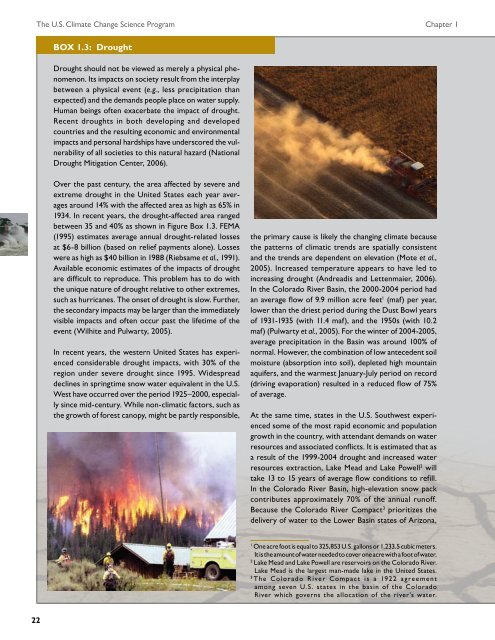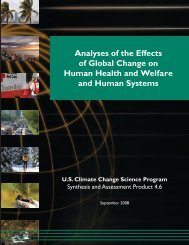Weather and Climate Extremes in a Changing Climate. Regions of ...
Weather and Climate Extremes in a Changing Climate. Regions of ...
Weather and Climate Extremes in a Changing Climate. Regions of ...
You also want an ePaper? Increase the reach of your titles
YUMPU automatically turns print PDFs into web optimized ePapers that Google loves.
The U.S. <strong>Climate</strong> Change Science Program Chapter 1<br />
22<br />
BOX 1.3: drought<br />
Drought should not be viewed as merely a physical phenomenon.<br />
Its impacts on society result from the <strong>in</strong>terplay<br />
between a physical event (e.g., less precipitation than<br />
expected) <strong>and</strong> the dem<strong>and</strong>s people place on water supply.<br />
Human be<strong>in</strong>gs <strong>of</strong>ten exacerbate the impact <strong>of</strong> drought.<br />
Recent droughts <strong>in</strong> both develop<strong>in</strong>g <strong>and</strong> developed<br />
countries <strong>and</strong> the result<strong>in</strong>g economic <strong>and</strong> environmental<br />
impacts <strong>and</strong> personal hardships have underscored the vulnerability<br />
<strong>of</strong> all societies to this natural hazard (National<br />
Drought Mitigation Center, 2006).<br />
Over the past century, the area affected by severe <strong>and</strong><br />
extreme drought <strong>in</strong> the United States each year averages<br />
around 14% with the affected area as high as 65% <strong>in</strong><br />
1934. In recent years, the drought-affected area ranged<br />
between 35 <strong>and</strong> 40% as shown <strong>in</strong> Figure Box 1.3. FEMA<br />
(1995) estimates average annual drought-related losses<br />
at $6-8 billion (based on relief payments alone). Losses<br />
were as high as $40 billion <strong>in</strong> 1988 (Riebsame et al., 1991).<br />
Available economic estimates <strong>of</strong> the impacts <strong>of</strong> drought<br />
are difficult to reproduce. This problem has to do with<br />
the unique nature <strong>of</strong> drought relative to other extremes,<br />
such as hurricanes. The onset <strong>of</strong> drought is slow. Further,<br />
the secondary impacts may be larger than the immediately<br />
visible impacts <strong>and</strong> <strong>of</strong>ten occur past the lifetime <strong>of</strong> the<br />
event (Wilhite <strong>and</strong> Pulwarty, 2005).<br />
In recent years, the western United States has experienced<br />
considerable drought impacts, with 30% <strong>of</strong> the<br />
region under severe drought s<strong>in</strong>ce 1995. Widespread<br />
decl<strong>in</strong>es <strong>in</strong> spr<strong>in</strong>gtime snow water equivalent <strong>in</strong> the U.S.<br />
West have occurred over the period 1925–2000, especially<br />
s<strong>in</strong>ce mid-century. While non-climatic factors, such as<br />
the growth <strong>of</strong> forest canopy, might be partly responsible,<br />
the primary cause is likely the chang<strong>in</strong>g climate because<br />
the patterns <strong>of</strong> climatic trends are spatially consistent<br />
<strong>and</strong> the trends are dependent on elevation (Mote et al.,<br />
2005). Increased temperature appears to have led to<br />
<strong>in</strong>creas<strong>in</strong>g drought (Andreadis <strong>and</strong> Lettenmaier, 2006).<br />
In the Colorado River Bas<strong>in</strong>, the 2000-2004 period had<br />
an average flow <strong>of</strong> 9.9 million acre feet 1 (maf) per year,<br />
lower than the driest period dur<strong>in</strong>g the Dust Bowl years<br />
<strong>of</strong> 1931-1935 (with 11.4 maf), <strong>and</strong> the 1950s (with 10.2<br />
maf) (Pulwarty et al., 2005). For the w<strong>in</strong>ter <strong>of</strong> 2004-2005,<br />
average precipitation <strong>in</strong> the Bas<strong>in</strong> was around 100% <strong>of</strong><br />
normal. However, the comb<strong>in</strong>ation <strong>of</strong> low antecedent soil<br />
moisture (absorption <strong>in</strong>to soil), depleted high mounta<strong>in</strong><br />
aquifers, <strong>and</strong> the warmest January-July period on record<br />
(driv<strong>in</strong>g evaporation) resulted <strong>in</strong> a reduced flow <strong>of</strong> 75%<br />
<strong>of</strong> average.<br />
At the same time, states <strong>in</strong> the U.S. Southwest experienced<br />
some <strong>of</strong> the most rapid economic <strong>and</strong> population<br />
growth <strong>in</strong> the country, with attendant dem<strong>and</strong>s on water<br />
resources <strong>and</strong> associated conflicts. It is estimated that as<br />
a result <strong>of</strong> the 1999-2004 drought <strong>and</strong> <strong>in</strong>creased water<br />
resources extraction, Lake Mead <strong>and</strong> Lake Powell 2 will<br />
take 13 to 15 years <strong>of</strong> average flow conditions to refill.<br />
In the Colorado River Bas<strong>in</strong>, high-elevation snow pack<br />
contributes approximately 70% <strong>of</strong> the annual run<strong>of</strong>f.<br />
Because the Colorado River Compact 3 prioritizes the<br />
delivery <strong>of</strong> water to the Lower Bas<strong>in</strong> states <strong>of</strong> Arizona,<br />
1 One acre foot is equal to 325,853 U.S. gallons or 1,233.5 cubic meters.<br />
It is the amount <strong>of</strong> water needed to cover one acre with a foot <strong>of</strong> water.<br />
2 Lake Mead <strong>and</strong> Lake Powell are reservoirs on the Colorado River.<br />
Lake Mead is the largest man-made lake <strong>in</strong> the United States.<br />
3 The Color ado River Compac t is a 1922 agreement<br />
among seven U.S. states <strong>in</strong> the bas<strong>in</strong> <strong>of</strong> the Colorado<br />
River which governs the allocation <strong>of</strong> the river’s water.




